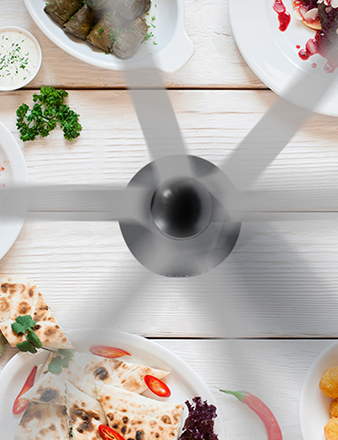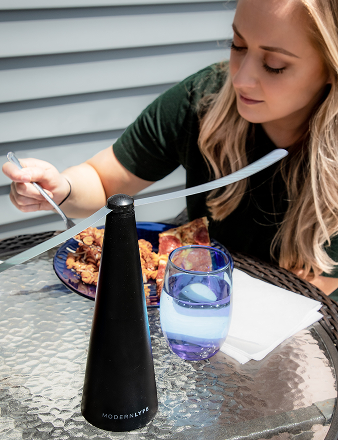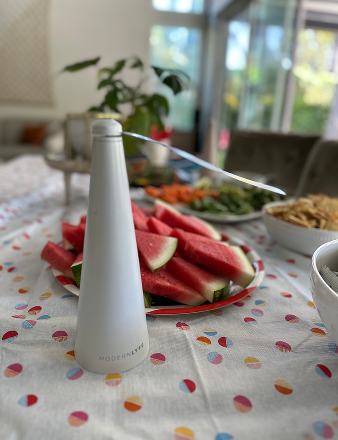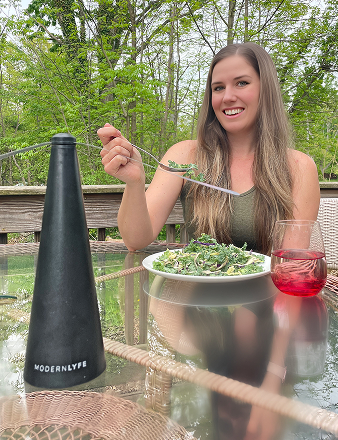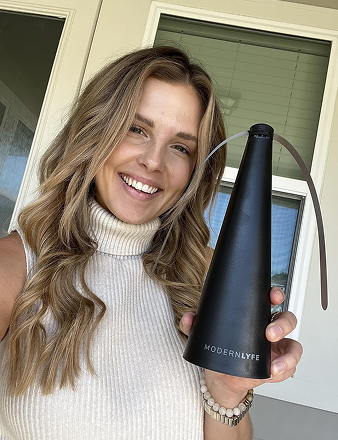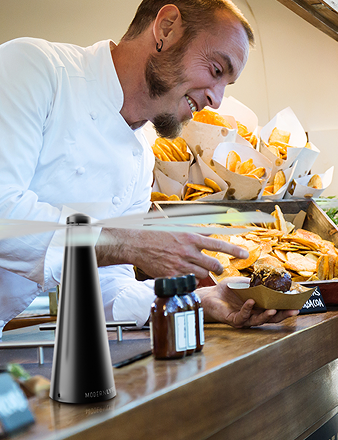When planning a camping trip, your tent is the obvious starting point. But the real success of your trip depends on the gear you bring with it. The right camping accessories transform a patch of wilderness into a comfortable, functional outdoor base.
These items are what make or break your experience, from the sleeping pad that insulates you from the cold ground to the headlamp that prevents a late-night fall. This gear is often more critical to your enjoyment than the tent itself.
Why the Right Accessories Matter More Than the Tent
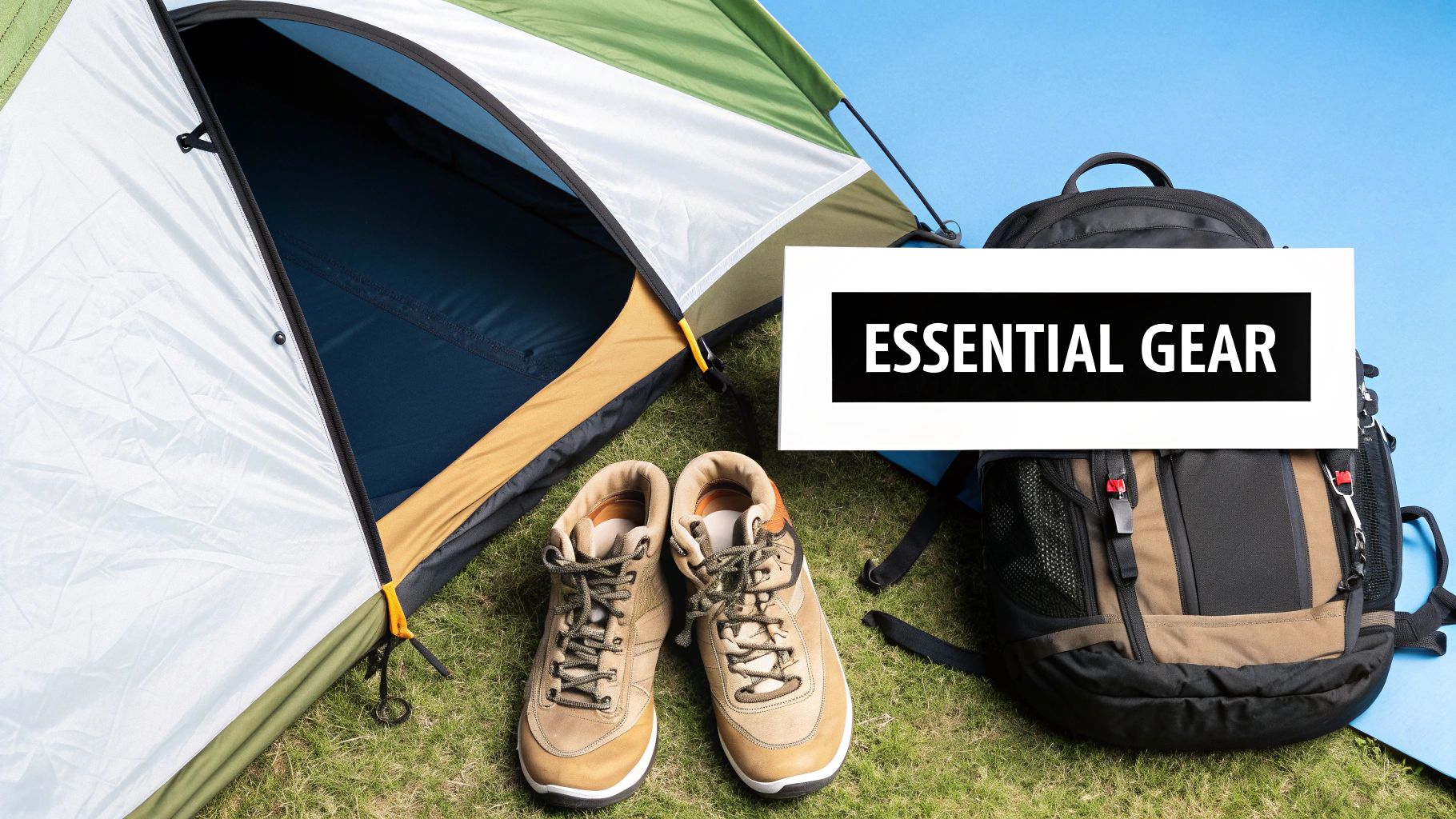
Think of your tent as the house and your accessories as the furnishings. A tent provides basic shelter from wind and rain, but the gear you bring dictates your comfort, safety, and overall experience. This is what separates simply surviving a night outdoors from truly thriving in nature.
This guide moves beyond a simple checklist. We will explore the accessories that fundamentally shape your outdoor experience. You will see how a few well-chosen items can transform a trip from a stressful ordeal into a memorable adventure. The right equipment doesn't just add convenience; it builds the confidence to get outdoors more often.
From Basic Shelter to Comfortable Campsite
A tent alone is just a fabric shell. The real living happens with the gear you put in and around it. A quality sleeping pad provides essential insulation and cushioning for a restful night's sleep. A powerful headlamp makes navigating a dark campsite effortless. A sturdy camp chair offers a front-row seat to the campfire.
These items directly solve the most fundamental challenges of camping:
- Warmth and Comfort: A quality sleeping bag and pad are your primary defense against the cold, hard ground. This is non-negotiable.
- Nourishment: A reliable stove and a simple cookware set can turn mealtime from a hassle into a highlight.
- Safety and Light: Headlamps, lanterns, and a well-stocked first-aid kit are essential after sunset.
Without these core accessories, even the most advanced tent is just a cold, empty box. These are the tools that solve the real problems you face at a campsite.
A great trip isn't about having the most expensive tent; it's about having the right tools to stay warm, well-fed, and safe. Your accessories are those tools.
Building a Smarter, More Efficient Camp Kit
Forgetting a critical piece of gear can quickly ruin an otherwise perfect trip. Trying to cook without a stove or navigating in the dark without a light source is a common but avoidable mistake. This is why a systematic approach to choosing and packing your gear is crucial.
This guide provides a practical framework for building your kit. We break down the world of camping accessories into four key categories: shelter, cooking, comfort, and safety. Use this as a blueprint, whether you're a first-timer assembling a setup or a seasoned camper refining your gear. Understanding the function of each item allows you to build an efficient, reliable, and personalized kit for any adventure.
Building Your Core Camping Kit
The world of camping accessories is vast, filled with gadgets promising to perfect your trip. The secret isn't to buy everything, but to build a solid foundation with smart, essential choices.
The most effective way to do this is to organize your gear into four essential categories. Think of it as building your campsite from the ground up. Master these four areas, and you’ll have a complete, reliable kit that covers everything from staying warm at night to cooking a great meal.
The growing interest in outdoor activities is clear. The global camping equipment market was recently valued at USD 19.57 billion and is projected to reach USD 20.85 billion, reflecting an annual growth of about 6.15%. This shows a significant trend in people investing in quality gear. You can discover more about the expanding camping market trends on Mordor Intelligence.
The Shelter and Sleep System
This is the cornerstone of your setup—your home away from home. It's what keeps you safe, warm, and comfortable. While the tent provides shelter, your sleep system is what ensures you get a restorative night's rest. A full eight hours of sleep is critical for enjoying your time in nature.
A poor night’s sleep can ruin a camping trip. If you’ve ever spent a night shivering on cold, hard ground, you know this firsthand. A proper sleep system creates a crucial buffer of insulation and cushioning, which is the key to waking up refreshed and ready for the day.
This diagram shows how shelter, insulation, and comfort work together to create the ideal sleeping environment.
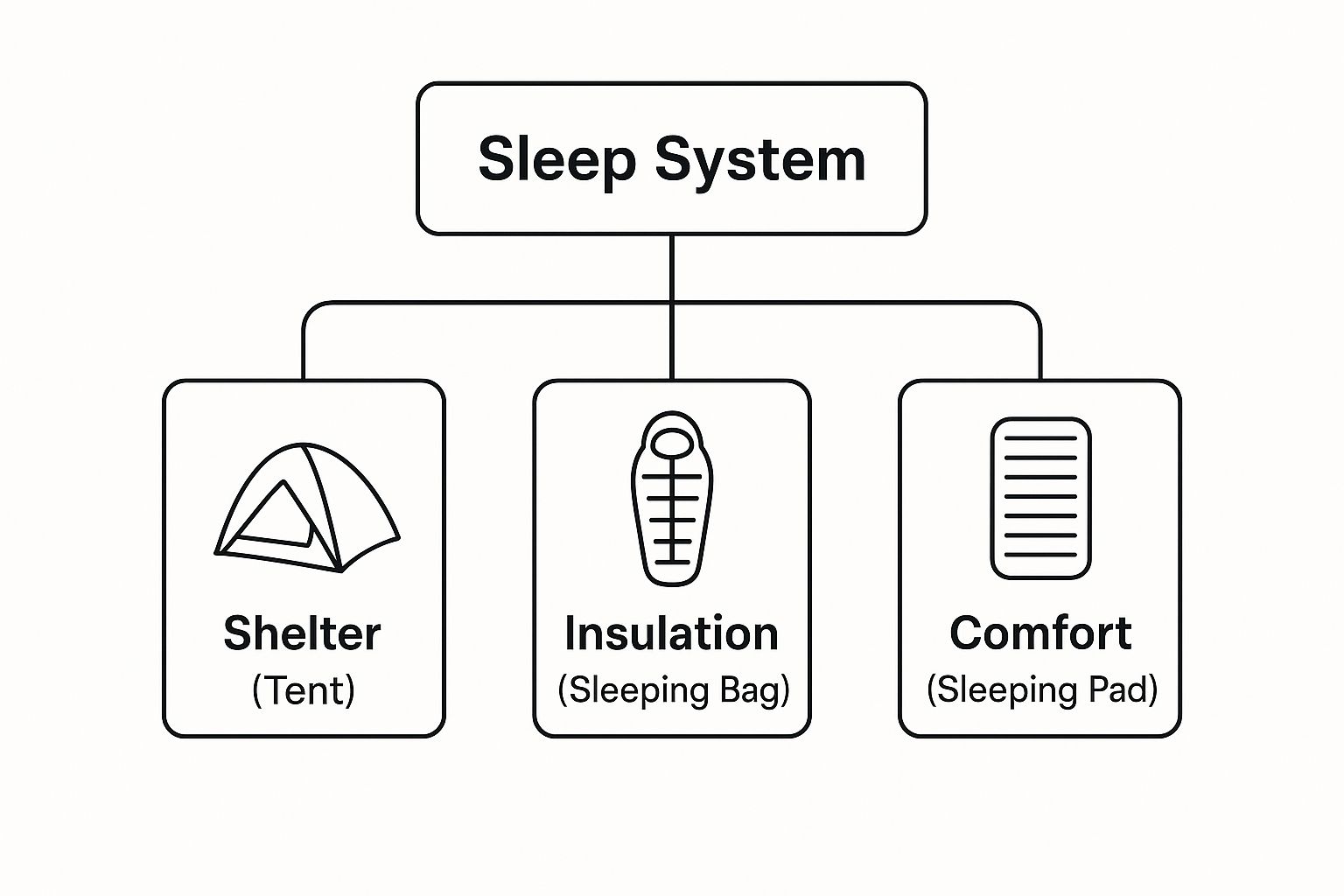
As you can see, it’s a balanced system where your tent, sleeping bag, and sleeping pad all play a critical role together.
The Camp Kitchen
Your camp kitchen is the heart of the campsite. It's where you'll brew your first cup of coffee and cook the meals that fuel your adventures. A well-designed kitchen setup turns cooking from a chore into one of the most enjoyable parts of the trip. It doesn’t need to be complex—just functional and reliable.
Here are the non-negotiables:
- Camp Stove: For car camping, a portable two-burner propane stove offers the flexibility to cook multiple items at once, similar to a home kitchen.
- Cooler: A quality cooler is essential for keeping food fresh and drinks cold, especially on multi-night trips.
- Cookware and Utensils: A simple mess kit, a durable cast iron skillet, and basics like a spatula and tongs are all you need to get started.
- Water Storage and Filtration: Always pack more water than you think you need. A large, dedicated container is ideal, but a water filter or purification tablets are a crucial backup.
An organized camp kitchen simplifies meal prep, freeing up more time to relax. It’s the difference between eating cold food from a can and enjoying a hot, satisfying meal under the stars.
Campsite Living Essentials
This category covers the items that transform your site into a comfortable outdoor living space. These are the camping accessories that make your campsite a place to hang out, not just a place to sleep.
Good lighting, for example, is a game-changer after sunset, enhancing both safety and ambiance. A headlamp is essential for hands-free tasks, while a lantern can illuminate the entire area for cooking or games. And never underestimate the value of a comfortable camp chair over a lumpy log or damp ground.
Many of these items are versatile. You can explore great accessories for picnics in our other guide to see how much of your gear can serve multiple purposes for different outdoor activities.
Safety and Navigation Tools
This is the gear you hope to never use but must always have. Safety is the top priority. Being prepared for a minor injury, a wrong turn, or an unexpected problem is part of responsible camping. Your safety kit doesn't need to be extensive, but it must be complete.
Every camper should carry these three items, without exception:
- A Well-Stocked First-Aid Kit: Ensure it’s appropriate for your group size and trip duration. It should include bandages, antiseptic wipes, pain relievers, and blister treatment.
- A Multi-Tool: This is an invaluable tool for everything from minor gear repairs to food preparation.
- Navigation Aids: While a phone's GPS is useful, batteries can die and signals can be lost. Always carry a physical map of the area and a compass as a reliable backup.
This checklist summarizes the essential items from the four core categories discussed.
Essential Camping Accessories Checklist by Category
| Category | Must-Have Items | Good-to-Have Items |
|---|---|---|
| Shelter & Sleep System | Tent, Sleeping Bag, Sleeping Pad | Pillow, Tarp/Footprint, Hammock |
| Camp Kitchen | Camp Stove, Cooler, Cookware, Water Storage | Coffee Maker, Camp Table, Wash Bins |
| Campsite Living | Camp Chairs, Headlamps, Lantern | Axe/Saw, Small Shovel, Clothesline |
| Safety & Navigation | First-Aid Kit, Multi-Tool, Map & Compass | Fire Starter, Bear Spray (if applicable), Whistle |
By building your kit around these four categories, you will create a setup that is balanced, functional, and safe, setting you up for successful and enjoyable adventures.
Choosing Gear That Fits Your Camping Style
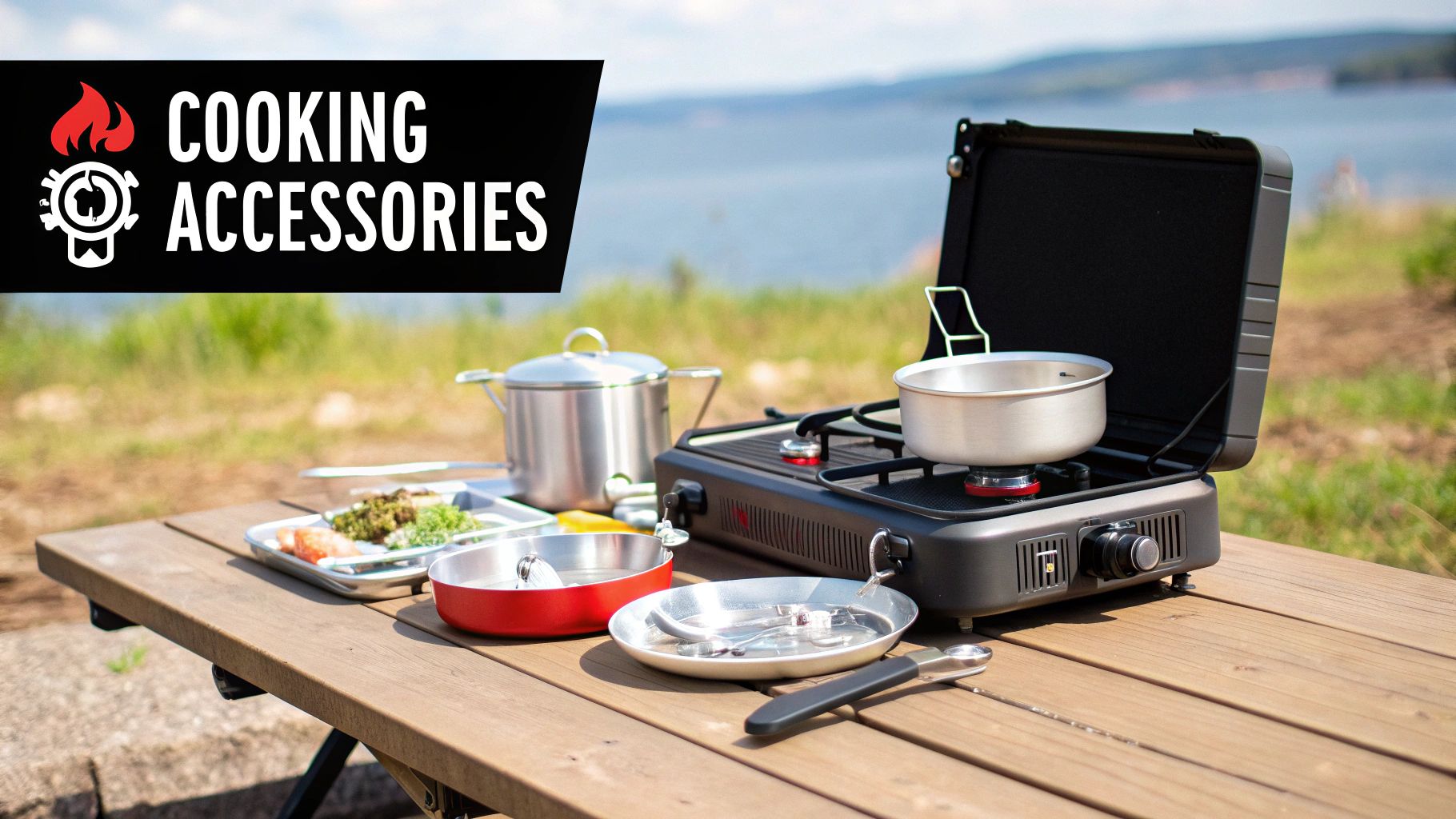
The world of camping accessories is massive, and it's easy to feel you need one of everything. The secret to building a great kit isn't owning the most gear; it's owning the right gear for your specific style of camping.
There is no single "best" set of accessories because every trip and every camper is different.
The logic is simple: you wouldn't use a compact car to haul lumber. The same principle applies to your camping setup. A heavy, feature-rich stove perfect for family car camping is completely impractical for a solo backpacker who counts every ounce.
This section will help you make smarter purchasing decisions. By first identifying your personal camping style, you can invest in gear that serves a real purpose, saving you money, space, and unnecessary weight.
Car Camping Versus Backpacking
The most significant factor influencing your gear choice is how you get to your campsite. This distinction creates two primary categories: car camping and backpacking, each demanding a different approach to accessories.
Car Camping: When your vehicle is your basecamp, weight and size are not major concerns. The priority shifts to comfort and convenience. This is your opportunity to bring larger, heavier, and more luxurious items that make your campsite feel like a home away from home.
- Priorities: Comfort, convenience, and features.
- Example Gear: Large multi-room tents, thick air mattresses, two-burner propane stoves, full-sized coolers, and comfortable camp chairs.
Backpacking: When you carry everything on your back, every ounce matters. The goal is to be as lightweight and compact as possible without compromising safety or essential function. Every piece of gear must justify its place in your pack.
- Priorities: Low weight, small packed size, and efficiency.
- Example Gear: Ultralight one-person tents, inflatable sleeping pads, compact canister stoves, and minimalist sit pads instead of full chairs.
Choosing your camping style first is the most important decision you'll make. It guides every other gear choice and ensures your equipment is right for the task.
Trip Duration and Group Size
Once you know how you're getting there, consider how long you'll be gone and who is coming with you. A quick solo overnight trip requires a much different kit than a week-long family adventure.
A solo camper on a weekend trip might only need a small pot and a single fuel canister. A family of four on a five-day trip will require a much larger cookset, multiple fuel sources, and significantly more food storage.
The same logic applies to shelter and comfort items. A larger group needs more sleeping space, more chairs, and more lighting. A longer trip requires more clothing, more food, and a plan for recharging electronics. Thinking through these details beforehand prevents you from being over- or under-prepared.
Factoring in Weather and Climate
The final consideration is the weather. The camping accessories you pack for a summer desert trip are entirely different from what you would bring on a fall mountain excursion.
Ignoring the forecast is a fast track to a miserable—and potentially dangerous—experience. Your gear must be appropriate for the expected temperatures, precipitation, and wind.
Here’s how weather changes your gear needs:
- Cold Weather: You need gear with better insulation, such as a sleeping bag with a lower temperature rating and a sleeping pad with a higher R-value (a measure of insulation). You'll also want warmer layers and a stove designed to perform in freezing conditions.
- Rainy Conditions: A tent with a full-coverage rainfly is non-negotiable. Waterproof bags to protect your gear, a tarp for a dry common area, and quality rain gear are essential.
- Hot and Humid Weather: Ventilation is key. A tent with ample mesh, lightweight and breathable sleeping gear, and a high-performance cooler to prevent food spoilage are critical.
This boom in outdoor recreation has fueled major market growth. Recent data shows the global camping equipment market was valued at around USD 89.81 billion, driven by a rising interest in outdoor activities.
Many car campers also enjoy cookouts, and the right tools are essential. For those who want a quality barbecue experience at the campsite, consider our guide on Weber BBQ grill accessories. By carefully considering your style, trip duration, group size, and weather, you can build a versatile and reliable kit perfectly matched to any adventure.
Real-World Gear Setups for Different Campers
Understanding the theory behind camping accessories is useful, but seeing it applied in the real world makes it click. Let's examine three distinct camper profiles. Each has a different objective for their trip, and their gear choices directly reflect their priorities.
Use these setups as templates to build a kit that fits your own style. By seeing how these loadouts are structured, you can quickly identify which approach best suits your needs.
The Weekend Car Camper
First is the weekend car camper, whose motto is simple: comfort is king. Driving directly to their campsite means weight and packability are not concerns. The goal is to create a relaxing, home-like basecamp for a couple of nights in nature.
This approach maximizes enjoyment by minimizing hassle. The gear is typically larger, more feature-rich, and designed for a comfortable stay. It's the ideal setup for anyone who loves the outdoors but doesn't want to sacrifice a good night's sleep or a great meal.
Here’s a look at their typical gear:
- Shelter: A large dome tent with standing room, often paired with a queen-sized, self-inflating air mattress.
- Kitchen: A classic two-burner propane stove, a large cooler packed with fresh food, and a complete set of pots, pans, and utensils.
- Comfort: Deluxe, high-back camp chairs with cupholders, a folding table for food prep, and string lights for ambiance.
- Key Insight: For the car camper, more is more. They bring the gear that transforms a simple campsite into a comfortable outdoor living room.
The Lightweight Backpacker
Next is the lightweight backpacker, the direct opposite of the car camper. For them, every ounce counts. Their focus is on efficiency, minimalism, and the freedom to travel deep into the backcountry on foot. Everything they need for survival must fit into a pack they can carry for miles.
The backpacker’s gear philosophy is an exercise in optimization. Every item must serve a critical function, and multi-purpose gear is highly valued. This setup is built for mobility and self-reliance, where the only resources available are those carried on your back.
A backpacker’s kit is a meticulously curated collection where every gram is scrutinized. The objective is to move through the wilderness with minimal effort and maximum freedom.
Their gear is defined by high performance and portability:
- Shelter: An ultralight one or two-person tent made from advanced, lightweight fabrics, paired with a compact, inflatable sleeping pad that packs down to the size of a water bottle.
- Kitchen: A small but powerful canister stove that boils water in minutes, a single titanium pot, and a spork.
- Comfort: This is where sacrifices are made. "Comfort" may be a small foam pad for seating, and a headlamp is the sole light source.
- Key Insight: The backpacker invests in advanced materials and minimalist design to reduce weight, allowing them to cover more ground and access remote locations.
The Family Adventurer
Finally, the family adventurer strikes a balance between comfort and practicality to ensure everyone, from young children to adults, has a great time. Their gear must be durable, versatile, and equipped for the organized chaos of a group trip.
Family camping is a logistical challenge. The gear must accommodate multiple people with varying needs, and entertainment is a must. Durability is critical, as equipment needs to withstand the high energy and "enthusiastic testing" of younger campers.
A typical family loadout includes:
- Shelter: A large cabin-style tent, often with room dividers, plus individual sleeping bags and pads for each family member.
- Kitchen: A robust cooking setup is essential. A large stove and a high-capacity cooler are needed to keep the entire crew fed and happy.
- Campsite Life: Multiple lanterns for ample lighting, a large tarp to create a rain-proof common area, and outdoor games to keep children entertained.
- Key Insight: The family adventurer prioritizes the shared experience. Their gear is chosen to make group meals, games, and evenings around the fire easy and enjoyable for everyone.
Packing and Maintaining Your Camping Accessories
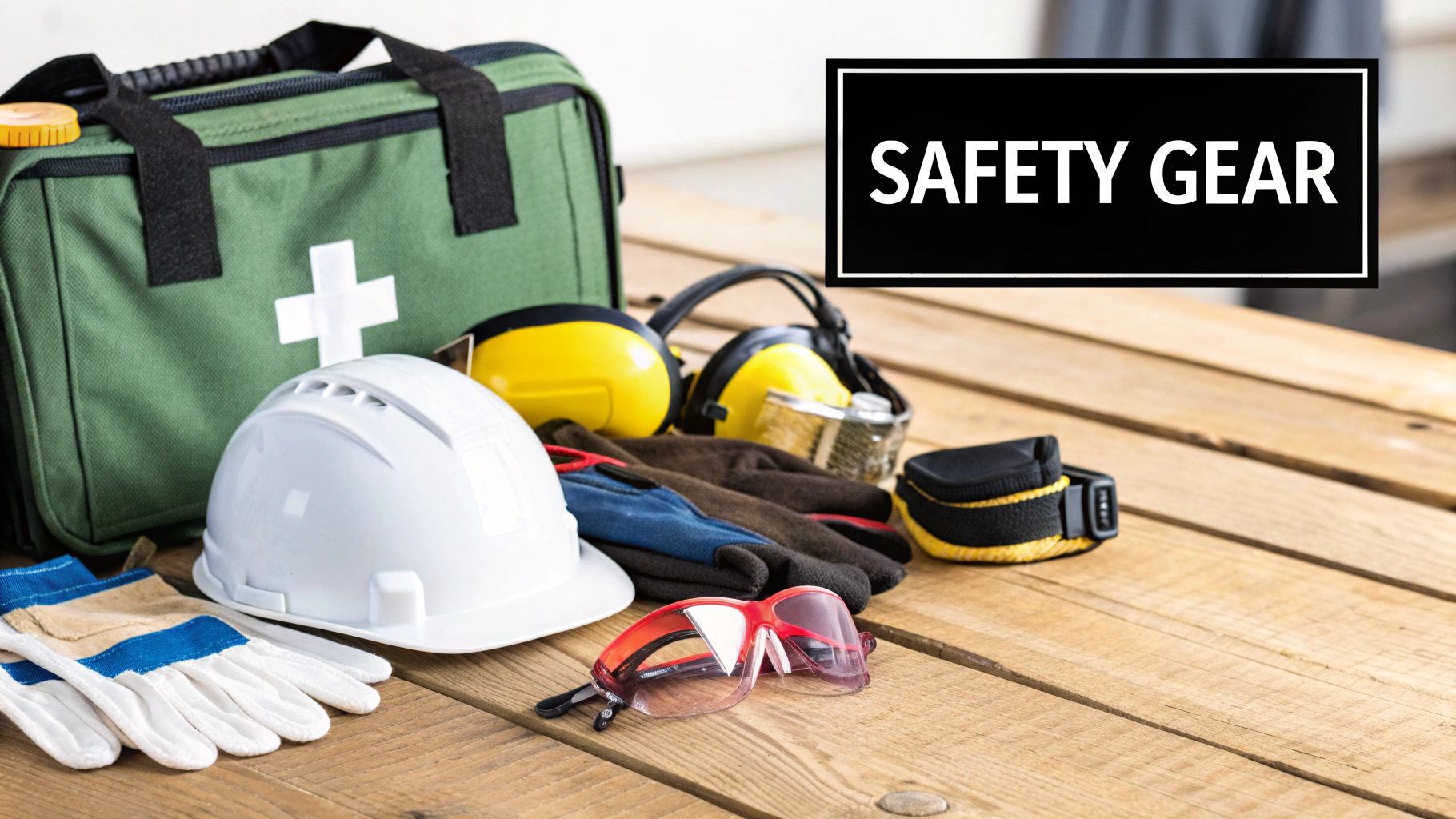
Owning the best camping accessories is only half the battle. Knowing how to pack and care for them is what distinguishes experienced campers. Proper packing and consistent maintenance ensure your gear performs reliably and lasts for years.
Think of your gear as an investment in your adventures. Treat it well, and it will be ready when you are.
The Art of the Organized Pack
Packing is more than just fitting everything into a bag. It's about smart organization, balanced weight distribution, and easy access to essential items. You shouldn't have to empty your entire pack to find your headlamp in the dark.
For backpackers, this means placing heavy items like your cook set and food in the middle of the pack, close to your spine, to maintain your center of gravity. For car campers, using labeled bins for different gear categories (e.g., kitchen, sleeping, lighting) transforms a chaotic trunk into an organized base camp.
This systematic approach saves time and frustration, enabling a quick, seamless camp setup. A well-organized kit is also versatile; many items are perfect for other outings, as detailed in our guide to essential picnic accessories.
Protecting Your Investment with Proper Maintenance
Your gear endures rough conditions, so post-trip care is non-negotiable. This prevents issues like mildew, rust, or a malfunctioning stove. Neglecting these simple steps is the fastest way to ruin your favorite camping accessories.
Incorporate these habits into your post-trip routine:
- Tent Care: Never store a damp tent. Always hang it to air dry completely to prevent mildew, which can degrade the fabric and its waterproof coating.
- Sleeping Bag Upkeep: Do not store your sleeping bag in its compression sack. Use a large, breathable storage bag to preserve the insulation's loft.
- Stove Maintenance: Clean your camp stove, inspect fuel lines for blockages, and confirm all parts are in working order. A reliable stove is critical.
This focus on quality, durable gear is a growing trend. After an initial dip, the camping equipment market has seen a resurgence, with a notable shift toward sustainable materials and innovative, lightweight accessories designed for longevity.
Think of gear maintenance as a task for your future self. Spending 30 minutes to clean and store your equipment properly today prevents the future you from discovering a moldy tent or a broken stove right before your next trip.
By making smart packing and routine maintenance part of your process, you ensure your gear remains in optimal condition. This discipline protects your investment and guarantees that every adventure starts with reliable tools you can count on.
Your Camping Accessory Questions, Answered
Every expert camper was once a beginner, and having questions is a natural part of gearing up. Here are answers to some of the most common inquiries to help you build your kit with confidence and avoid rookie mistakes.
What are the absolute must-have camping accessories for a beginner?
When you're just starting, focus on the essentials that ensure your safety and comfort. You can add specialized gadgets later, once you discover what kind of camping you enjoy most.
Your non-negotiable starter pack should include:
- A reliable tent that you have practiced setting up.
- A sleeping bag rated for the expected nighttime temperatures.
- A sleeping pad for both warmth and comfort.
- A headlamp for hands-free lighting.
- A basic first-aid kit.
- A reusable water bottle, preferably with a built-in filter.
- A simple, single-burner camp stove for hot meals and drinks.
How do I decide between expensive and budget-friendly gear?
The decision depends on your intended use. If you plan to car camp a few times a year in mild weather, quality budget-friendly gear from a reputable brand will serve you well.
However, if you have more demanding plans—such as multi-day backpacking, winter camping, or frequent trips—investing in higher-end gear is a smart choice. The higher price typically buys lighter materials, more durable construction, and better performance in challenging conditions. It is a direct investment in your comfort and safety.
Treat your gear like a long-term investment. High-quality camping accessories may cost more upfront, but their durability and reliability often save you money over time by eliminating the need for frequent replacements.
What is the best way to store my camping accessories?
Proper storage is as important as proper use for extending the life of your gear. The number one rule is to ensure everything is completely clean and dry before you put it away. This is the best defense against mold, mildew, and rust.
For long-term storage, remove tents and sleeping bags from their tight compression sacks and store them in large, breathable bags. This helps maintain the insulation loft in your sleeping bag and prevents the waterproof coatings on your tent from degrading. A cool, dry, dark place like a closet or a garage corner is ideal. Using clear, labeled plastic bins for smaller items keeps them organized and protected.
At MODERN LYFE, our goal is to enhance every experience, whether indoors or out. As you prepare your campsite meals, keep them pest-free with our stylish and effective fly fans. Discover the perfect solution for your campsite kitchen at MODERN LYFE.

